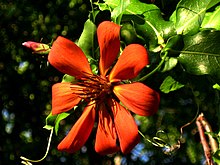| Mutisioideae | |
|---|---|

| |
| Mutisia cana | |
| Scientific classification | |
| Kingdom: | Plantae |
| Clade: | Tracheophytes |
| Clade: | Angiosperms |
| Clade: | Eudicots |
| Clade: | Asterids |
| Order: | Asterales |
| Family: | Asteraceae |
| Subfamily: | Mutisioideae (Cass.) Lindl. |
| Tribes[1] | |
The Mutisioideae are a subfamily in the plant family Asteraceae that includes about 630 species assigned to 44 different genera. This subfamily is mainly native in South America, except for Adenocaulon, Chaptalia, Gerbera, Trichocline, which have species in all continents other than Europe and Antarctica. Common characters are the deeply incised corollas of the disc florets, with five lobes, sometimes merged in two lips, flower heads with overlapping involucral bracts, anthers with tails and pointy tips, the styles usually stick far out of the florets and are essentially hairless. Most species are herbs, but some are vines, shrubs, or small trees.[2]
- ^ "Subfamily Mutisioideae". Taxonomy. UniProt. Retrieved 2010-02-18.
- ^ Panero, Jose L.; Funk, V.A. (2008). "The value of sampling anomalous taxa in phylogenetic studies: Major clades of the Asteraceae revealed" (PDF). Molecular Phylogenetics and Evolution. 47 (2): 757–782. doi:10.1016/j.ympev.2008.02.011. PMID 18375151. Retrieved 2017-01-05.